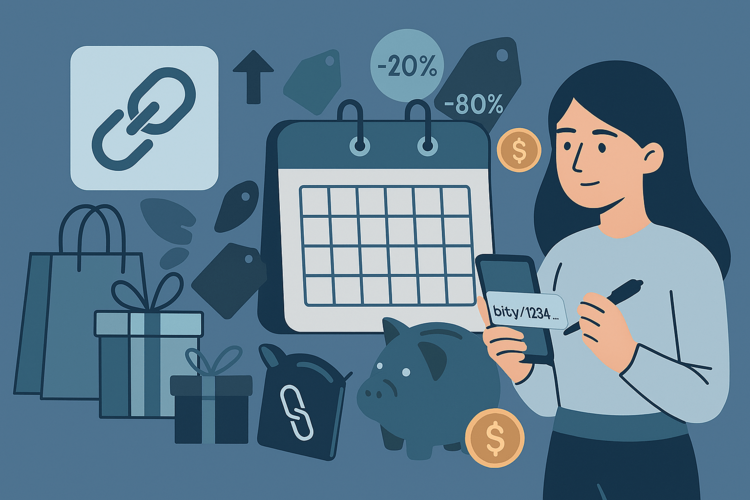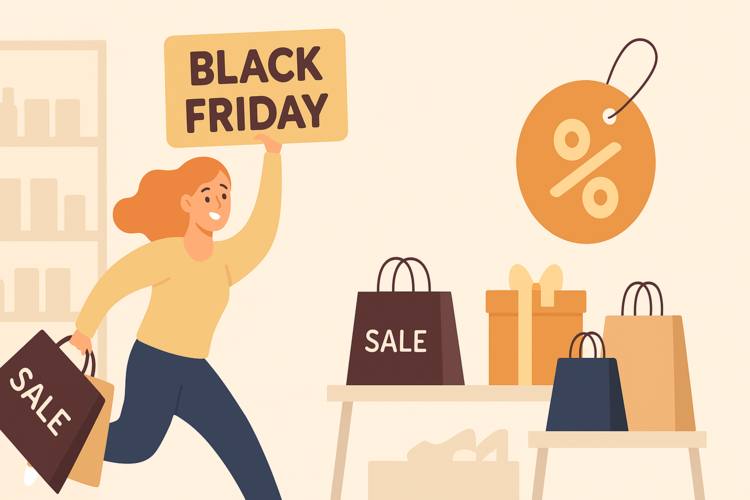Black Friday is not just a day when brands post big numbers and fight for CPM on Facebook. It is a field of experiments where marketers act like directors, change the rules of the game and do something that is more memorable than a discount. Successful brands have long understood: you can’t impress a buyer with just “–70%”. You need to touch them with a story, an emotion, a constraint, a value or at least a good trolling of competitors.
Catch your Black Friday bargain and make your links smarter.
Register on surl.li and control your links!
So below are ten real-life cases that show how Black Friday can work when it has brains, humor, and a little fearlessness.
10 stories where Black Friday became art, not a “–70%” banner
Black Friday is not about screaming in lines or racing for the cheapest TV. It's a day when brands create magic: they break the rules, play with emotions, turn on irony or, conversely, create campaigns with an ethical message. And the most interesting thing is that it's not the one who gives the biggest discount that wins, but the one who does it wisely.
Below is a selection of cases where Black Friday turned into a creative performance.
1. Patagonia — “Don’t buy this jacket”
Patagonia has long positioned itself as a brand that plays not on capitalism, but on thoughtful consumption. On Black Friday, they released an ad called "Don't buy this jacket," urging people not to buy a new one if their old one is still in good condition. The campaign seemed almost anti-commercial—and that's why it worked. People saw a genuine position, not a marketing gimmick. Paradoxically, honesty backfired: sales soared, PR swept all the media, and the brand finally established itself as the voice of environmental consciousness in the fashion industry.
2. Cards Against Humanity - "We Dig a Hole"
This brand always lives on the edge of absurdity, and Black Friday for them is an excuse to play the world on an even bigger scale. Cards Against Humanity, known for its dark humor, announced a fundraiser to… dig a hole in the ground. No goal. No benefit. Just a hole. It was a tough trolling of the culture of mindless shopping. People donated thousands of dollars simply out of a desire to see how deep the experiment would go. The result was over $100k in fundraising, dozens of viral stories in the media, and proof that humor and self-irony can sell just as well as traditional discounts.
3. Rozetka — “Dark Mode as an Event”
Ukrainian Rozetka has long turned Black Friday into a national sport. For several years in a row, they turned off the "regular" version of the site and launched a special "black and dark" version with a different identity, a different UI and separate functionality. This created a sense of an event, not just discounts. It worked because people like to feel like they are part of the "big days" - even in digital. The result: crazy traffic, viral screenshots of the "new" Rozetka and traditional shopping records.
4. Monobank — “Cashback as the country's main discount”
Monobank made a move on Black Friday that was not related to goods at all — they gave increased cashback in 5–10 categories at once (technologies, clothing, marketplaces). This turned the Black Friday into a day for “cashback hunters”: people started buying where they felt a double effect — both a discount and cashback on top. It worked, because the bank didn’t sell anything physical, but it became a key player of the day. The result: millions of transactions and a record level of activity in the app.
5. Kachorovska — “Instead of a discount — durability”
Instead of dumping old collections “up to -70%”, the brand took an unexpected course: they offered free shoe maintenance, repairs and upgrades for those who buy a pair during the sale. No dumping – on the contrary, value enhancement. It worked, because now the buyer received not just shoes, but “durability and care”. The result: sold-out models and a wave of positive reviews that the brand “does not get cheaper, but respects the customer”.
6. IKEA — "Buy with your time"
IKEA turned the logic of prices upside down: some products could be bought not with money, but with the minutes people spent getting to the store. The further you live, the bigger your “discount.” This emphasized their main idea: accessibility and respect for customers’ time. The campaign became not only marketing, but also social. People liked the idea that their time had value. The result was an increase in offline store traffic and a global wave of discussion in the media.
7. LEGO — “Exclusive instead of discount”
LEGO understands its audience — fans don’t chase deals, they hunt for rare items. Instead, they give away exclusive mini-sets that can’t be bought separately. For LEGO fans, the word “exclusive” sounds stronger than “deal.” This creates a scarcity effect — and scarcity sells. The result is instant sell-outs of sets, online queues, and dozens of viral unboxing videos.
8. Booking.com — “Buy your future trip cheap”
Booking has learned to sell dreams, not discounts. During emergencies, they offer great hotel deals… for future seasons. People book summer in the winter, when they’re sitting in a blanket and dreaming of the sea. This plays on both FOMO and the emotions of planning. The result is an explosion of cash flow and hotels that are booked in advance.
9. Novaya Poshta — “Backstage of Black Friday”
Instead of banners with discounts, the emergency service showed what is usually hidden: the live operation of sorting centers, the number of parcels in real time, midnight shifts. People saw that their purchases would not be "frozen" and would arrive. This created trust in the service and reduced the stress of buyers who are afraid of delays during emergencies. The result was a record number of shipments and positive feedback on social networks.
10. Silpo — “Gamified Black Friday”
Silpo turned the emergency into a game: quests, random gifts, surprise packages, QR events in the hall appeared in the application. People came not just for a discount, but to "play" and win something extra. This approach works better than banners with percentages, because it creates emotion and excitement without risk. The result is increased traffic in physical stores and a record number of activated bonuses in the loyalty program.
Bonus example: HyperHost - "Real Black Friday"
Among digital services, there are often manipulative ones, or those that contradict the very essence of the events - “Black Friday all month” or “Black Friday weeks”. HyperHost decided to remain true to tradition and does -90% but for a clearly limited period, only 24 hours on the day of “Black Friday”. Such a message allows you to form the best offer among hosting companies, and avoid manipulative headlines.
Trends from cases — what unites successful campaigns
If you look closely at all the examples — from Patagonia to Rozetka and Silpo — it becomes clear: Black Friday has long ceased to be about "who will give -80%". Really strong campaigns work on completely different mechanics. It's not about shouting "cheap!", but about giving a person a feeling that they don't get on other days of the year.
The first thing that unites successful cases is emotion. Patagonia provokes, Cards Against Humanity laughs, Kachorovska talks about caring, Silpo arranges a game. People buy not because it is "profitable", but because the brand made them feel something - to smile, to think, to feel like a participant in something bigger.
The second common element is limitation. Limited LEGO gifts, Nike early access, Rozetka’s one-day “dark mode” — all of these are games of scarcity. When there is an impression that “the moment can be missed,” the brain accelerates the decision. This works much better than any thousands of discounted products.
The third trend is the value that remains after the sale. Apple gives gift cards, Kachorovska offers free service, Booking offers the opportunity to buy a summer vacation in the middle of winter. This is not a one-time "good deal", it is a bonus that lasts longer than the emergency and enhances the feeling of benefit.
Fourth — environmental friendliness and responsibility. Patagonia raised this to the level of a manifesto. But the trend is already taking place all over the world: brands that talk about awareness win even on a day of total shopping. People don’t want to be “mindless shoppers,” but want, at least for a minute, to feel that they are doing something right.
And finally — personalization. Steam shows you the games you will actually play. Monobank gives cashback exactly where you buy most often. Even Ukrainian retailers are increasingly adjusting promotions to the behavior of the buyer. Universal banners no longer work — the one who appeals to a specific person, not to the crowd, wins.
As a result, the most successful Black Fridays are not about “who sold the cheapest,” but “who created an experience that you want to remember.” And this trend only gains momentum every year.
Conclusion: What local brands can learn from
Ukrainian brands don't have to copy the giants' discounts, but you can take their approach. Create stories that last longer than the promotion. Add meaning to the mechanics: a bonus, an exclusive, something "personal". Don't forget about honesty, because consumers instantly feel fake discounts. And most importantly: Black Friday is not about "getting everything at -90% off", but about the opportunity to show the character of the brand. Then buyers will come back not for the promotion, but for you.




